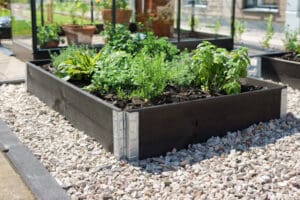Gardening is a fulfilling hobby that not only yields beautiful blooms and delicious produce but also offers numerous mental and physical health benefits. However, before you start digging into the dirt, it’s essential to decide on the right type of garden for your space and needs. Two popular options are in-ground gardens and raised-bed gardens, each with its own set of advantages and considerations. So, how do you decide if an in-ground or raised-bed garden is best for you? Here’s some information to consider about each style.
 In-Ground Gardens: Traditional Roots
In-Ground Gardens: Traditional Roots
In-ground gardens, as the name suggests, involve planting directly into the native soil. This method has been used for centuries and offers several benefits:
1. Cost-Effectiveness: Setting up an in-ground garden is often less expensive than building raised beds. There’s no need to invest in additional materials like lumber or soil.
2. Natural Integration: Plants in an in-ground garden have direct access to the soil’s nutrients, allowing them to establish strong root systems and thrive in their natural environment.
3. Space Flexibility: In-ground gardens can be customized to fit any size or shape of the available space, making them suitable for both small urban yards and larger rural properties.
4. Low Maintenance: Once established, in-ground gardens generally require less maintenance than raised beds. There’s no need to worry about replacing deteriorating materials or topping up soil levels.
However, in-ground gardens also come with some drawbacks:
1. Soil Quality: The quality of the native soil can vary significantly depending on location. In some areas, it may be nutrient-poor or compacted, requiring amendments to improve growing conditions.
2. Weed Control: Weeds can be more challenging to manage in an in-ground garden, as they have direct access to the same soil as your plants. Regular weeding and mulching are necessary to keep them under control.
3. Accessibility: Bending and kneeling may be required for tasks like planting, weeding, and harvesting, which can be challenging for individuals with mobility issues.
Raised-Bed Gardens: Elevated Growing
Raised-bed gardens consist of enclosed boxes filled with soil, usually constructed from wood, stone, or other durable materials. This method offers its own set of advantages:
1. Improved Soil Quality: By filling raised beds with a custom soil mix, you can create the perfect growing environment for your plants, with optimal drainage, aeration, and nutrient levels.
2. Better Drainage: Raised beds are elevated above ground level, which helps prevent waterlogging and allows excess moisture to drain away more efficiently, reducing the risk of root rot and other water-related issues.
3. Weed Suppression: Raised beds provide a barrier between your plants and the surrounding soil, making it easier to control weeds. Installing a weed barrier at the bottom of the bed can further reduce weed infiltration.
4. Accessibility: The elevated height of raised beds makes gardening more accessible for people with limited mobility, as it reduces the need for bending or kneeling. This can be especially beneficial for older adults or those with disabilities.
However, raised-bed gardens also have some drawbacks to consider:
1. Initial Cost: Building raised beds can be more expensive than starting an in-ground garden, particularly if you opt for high-quality materials like cedar or stone. Factor in the cost of soil mix as well.
2. Space Limitations: Raised beds are confined to the size and shape of the boxes, which may not be suitable for irregular or limited spaces. You’ll need to plan your layout carefully to make the most of the available area.
3. Maintenance: While raised beds require less bending and kneeling, they may need more frequent maintenance in terms of replacing soil mix, repairing or replacing bed materials, and watering regularly due to their elevated position.
Making the Decision Between an In-Ground or Raised-Bed Garden
When deciding between an in-ground or raised-bed garden, consider the following factors:
1. Space: Assess the size and shape of your gardening area to determine which type of garden will fit best.
2. Soil Quality: If your native soil is poor or compacted, raised beds may offer a more viable growing solution.
3. Budget: Determine how much you’re willing to invest upfront and over time in terms of materials, soil, and maintenance.
4. Accessibility: Consider your own mobility and any potential barriers to gardening comfortably.
Visit Hilton Landscape Supply for Your Gardening Needs
Ultimately, both in-ground and raised-bed gardens have their own unique advantages and challenges. By carefully weighing these factors and considering your own preferences and needs, you can choose the option that’s best suited to help your garden thrive. Regardless of the style you choose, Hilton Landscape Supply has all the soil, gravel, and amendments you need for a thriving garden this season. Stop by, and let’s get growing!

 In-Ground Gardens: Traditional Roots
In-Ground Gardens: Traditional Roots